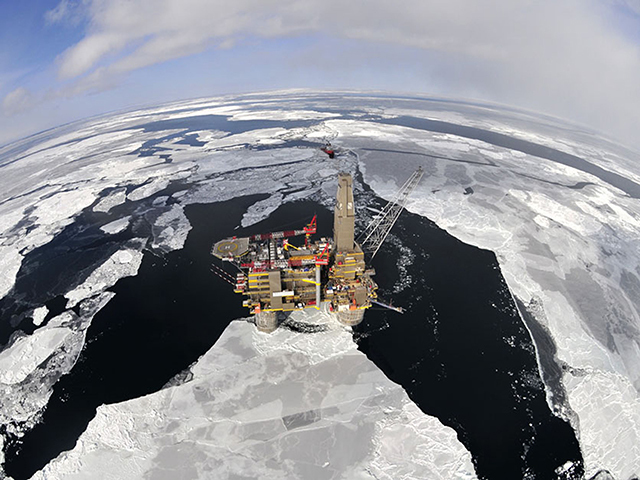
While the world focuses on Russia’s oil- freeze talks with OPEC, there are discussions behind closed doors in the Kremlin that will have a much more significant impact on the nation’s energy industry.
The petrodollars that underpin Russia’s national budget are evaporating. When crude prices were high, increasing revenue simply meant encouraging companies like Rosneft OJSC and Lukoil PJSC to push output higher, said Alexander Nazarov, an oil and gas analyst at Gazprombank. Now the Kremlin and the companies must figure out a new way to divide up the bounty, even measures that could harm output in the long term, he said.
“The Russian budget is starving,” Nazarov said by e-mail. “The government understands that with a tax hike it would hurt future prospects, but it has no choice.”
While President Vladimir Putin has reasserted control of oil and gas production, much of the industry remains independent — managed through a delicate balancing act that maximized tax revenue while supporting growth. For a decade the strategy succeeded as output grew to a post-Soviet record while supplying about half budget revenue. The collapse in crude prices destroyed the equilibrium, leaving Russia facing a deficit and a second year of recession.
In response to the slump, Russian producers are already curbing the investment needed to keep the oil and gas flowing, a process that could accelerate if the Kremlin raises taxes. Nevertheless, their profits are a tempting source of extra revenue, particularly as the weaker ruble has offset the impact of the decline in dollar-denominated crude prices.
Rosneft, the nation’s biggest producer, will report adjusted net income of 487 billion rubles ($6.6 billion) for 2015, according to a Bloomberg survey of 17 analysts, a 40 percent increase from the previous year. Lukoil, which reports in dollars, is projected to post a 9.5 percent decline in earnings to $4.27 billion for 2015. In the Russian currency, the company’s adjusted profit is estimated to have risen 72 percent to 313 billion rubles.
Royal Dutch Shell Plc, Europe’s largest oil company, reported a 53 percent drop in dollar-denominated adjusted net income last year.
Traditionally the Kremlin has carefully managed the tax regime for oil producers, assigning higher rates to the bulk of low-cost fields dating from the Soviet era while taking less from costlier new projects including offshore or heavy crude. Even for lower-cost producers the government has eased rates over the years.
Higher Taxes
It diverted from this gradual decrease in the tax burden last year, implementing new rules for 2016 that are expected to collect 200 billion rubles more than previously planned from the industry, Economy Minister Alexei Ulyukayev said last year. The state also approved two increases in sales tax on fuels such as gasoline and diesel, only part of which the companies may be able to pass along to customers at the pump.
A proposal from the Finance Ministry to increase the tax burden again could cost the industry about $11 billion of earnings in 2017, according to VTB Capital. The state “might take as much as it wants, this depends on the general situation in the economy,” said Dmitry Loukashov, an analyst at the bank.
The government has made no final decision on whether to implement the proposals, Deputy Prime Minister Arkady Dvorkovich said last month.
Reduced Investment
Oil producers asked to be left alone in a Jan. 27 meeting with the Energy Ministry, according to Bashneft Chief Executive Alexander Korsik. The government may be receptive to that argument.
The Kremlin has been very clear that raising taxes isn’t an attractive option and they will only do it if they cannot balance the budget otherwise, said Ivan Mazalov, who helps to manage $2 billion at Prosperity Capital Management Ltd. The government is still able to cut spending, borrow, raise money from privatization and ask for higher dividends from state- controlled companies, he said.
Producers are already responding to the price slump in a way that could affect output. Lukoil’s billionaire Chief Executive Officer Vagit Alekperov curbed spending last year to about $9 billion, about $1.5 billion less than 2014, and plans keep it around that level until 2017. Rosneft’s capital spending fell in dollar terms in 2015 compared with 2014. The weaker ruble means the company will actually increase spending in the local currency by about a third this year and next year, compared with 2015.
The Energy Ministry expects the industry’s seven-year expansion to end this year, with output stable near 2015 levels. In the ministry’s worst-case scenario, where prices are still about $40 a barrel by 2020, production may slump 14 percent in the next five to 10 years.
Tough Market
An expected increase in oil prices in the second half could also help ease the pressure on the nation’s budget, according to HSBC Holdings Plc, which raised its recommendation on Rosneft to hold last month. Brent crude recovered to above $40 a barrel for the first time since December this week, compared with a low of about $27 in January, after major producers including Saudi Arabia and Russia reached a tentative agreement to freeze output.
Prices may go lower if oversupply and weak economic growth persist, according to Edward Chow, a senior fellow at the Center for Strategic and International Studies in Washington. The historical average price of oil over the last 155 years is in the mid-30s in today’s dollars, while the Russian budget is based on $50 oil, he said.
“If I were a Russian oil producer, particularly if I am not majority owned or favored by the government, I would be worried about the government take going up in the next couple of years,” Chow said.
Recommended for you
